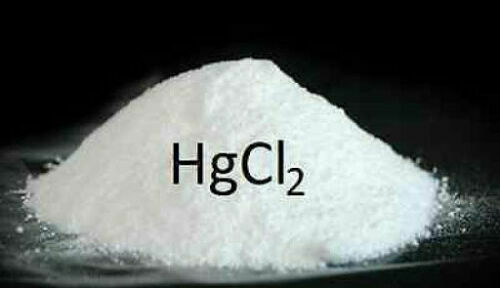-40%
MercuryChloride 99,8% FOR GAS CHROMATOGRAPHY 7487-94-7
$ 31.67
- Description
- Size Guide
Description
Detailed Product Description:Mercuric chloride or mercury (II) chloride, a white powder of colorless
and odorless, rhombohedral crystals, soluble in water. It is also called
bichloride of mercury or corrosive sublimate.
It was formerly used widely, however it is one of the most toxic forms of
mercury due to its high solubility in water.
Its solubility increases from
6% at
20 °C
to 36% in boiling water.
In the presence of chloride ions, it
dissolves to give the tetrahedral coordination complex [HgCl
4
]
2-
.
Grade/Purity:
This is Reagent-Grade material with a minimum purity of 99.8%
Background:
Mercuric chloride is prepared by reacting mercury with chlorine gas or
by subliming a mixture of mercuric sulfate and sodium chloride (common salt).
Applications
Until recently, the main application of mercuric chloride is as a catalyst for
the conversion of acetylene to vinyl chloride, the precursor to polyvinylchloride
(PVC).
Historical uses included use as a photographic intensifier to produce positive
pictures in the collodion process of the 1800s. When applied to a negative,
the mercury(II) chloride whitens and thickens the image, thereby increasing the
opacity of the shadows and creating the illusion of a positive image.
For the preservation of anthropological and biological specimens during the late
19th and early 20th centuries, objects were dipped in or were painted with a
"mercuric solution." Objects in drawers were protected by scattering crystalline
mercuric chloride over them.
Mercuric chloride is sometimes used in dilute solution as an antiseptic for
inanimate objects and as a fungicide. It is also used in preparing other
mercury compounds. It reacts with mercury metal to form mercurous chloride.
Other significant applications of mercuric chloride include its use as a depolarizer
in batteries and as a reagent in organic synthesis and analytical chemistry.
Mercuric chloride is occasionally used to form an amalgam with metals, such
as aluminum. Upon treatment with an aqueous solution of mercuric chloride,
aluminum strips quickly become covered by a thin layer of the amalgam.
Normally, aluminum is protected by a thin layer of oxide making it inert. Once
amalgamated, aluminum can undergo a variety of reactions. For example, it
will dissolve in water. Amalgamated aluminum is also used as a reducing agent
in organic synthesis. Zinc is also commonly amalgamated using mercuric chloride.
Precautions/
Toxicity:
Mercuric chloride is toxic and corrosive. It is both acutely poisonous
and as a cumulative poison.
Once absorbed into the bloodstream, inorganic mercury combines with proteins
in the plasma or enters the red blood cells. The liver is a major site of metabolism
for mercury, and all mercury absorbed from the stomach and intestine is carried
in the blood directly to the liver. It accumulates in the kidneys, and may cause
severe damage. Poisoning can result from inhalation, ingestion, or absorption
through the skin.
Customers Note
Shipping:
We only ship to paypal confirm address. Please match your address with paypal before you make a payment.
We ship worldwide! Buyers are responsible for duty tax. Please kindly leave your phone number for fill out international shipping label purpose.
We use standard EMS,USPS,UPS,FEDEX,DHL shipping. Faster shipping is available upon request. Extra shipping charge will apply.
All products will be ship within 24 hours (except Saturday, Sunday, and Holidays).
Combine shipping is available.
Contact us:
Please just contact us no hesitation via eBay message system if you have any question about the items you interested in. We will be very glad to help you.
We try our best to reply to your emails ASAP.









